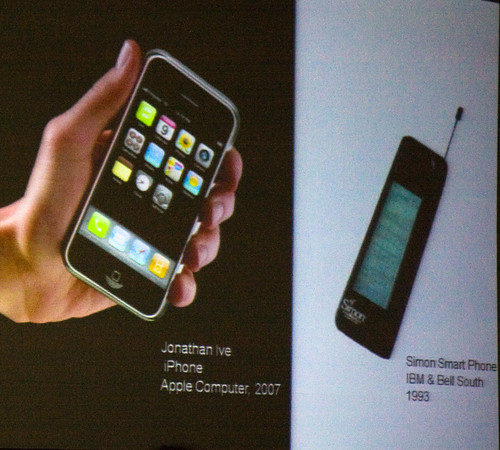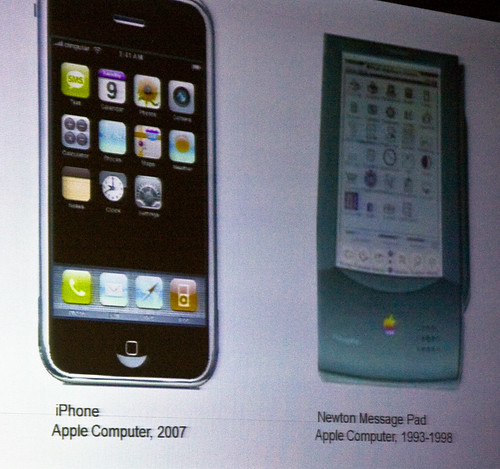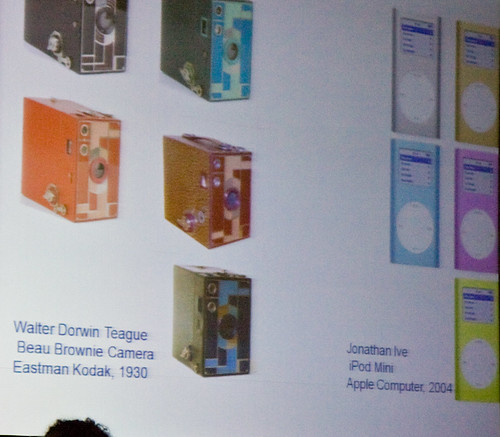Okay, this photo has nothing to do with Bill Buxton’s keynote, except for that it’s a photo planet I made at CHI this year in Florence. The closing plenary talk was the most inspiring talk I heard at CHI. I wasn’t planning on taking notes, but as soon as he said he’d thrown out the talk that he originally planned to give, i got out my laptop and started typing. If I’ve missed any key points, please let me know! Here goes:
Bill Buxton Being Human in a digital age
Technologies are developed with the best of intentions, but they affect the very nature of our humanity.
About Bill and This Talk
I made this talk up this week, so it was a stressful week for me. I knew I had to give something special for my lifetime achievement award acceptance talk, and I wanted to give you guys a talk that you’d never heard before. I chose my parents really well. I grew up in Toronto in a culture of setting the bar very high, which can be learned. You can learn about setting the bar really high, and make a huge difference.
Cellini wasn’t a Sculptor
The Perseus with the head of Medusa, by Cellini in 1545; Cellini wasn’t a sculptor. He worked on it for seven years. He struggled, but he did it anyway. He was a craftsman, not a sculptor. It’s like I always say, you have to have your feet in the mud, but your head in the clouds. “Feet in the mud” is being able to do wood working or soldering or something physical, but “head in the clouds” is a knack for abstract thought.
Kranzberg’s 1st Law
Technology is not good,
Technology is not bad,
But nor is it neutral.
Buxton’s corollary is that technology is not neutral. It’s actually going to be good, or bad, or both. That means that every paper clip we put into an office has an impact on that culture. We need to think about that.
Kranzberg’s 2nd law
Invention is the mother of necessity. When you do put that paper clip in the office you will get some things wrong, but you will hopefully learn what to change
Cultural Change
We’re doing big cultural change by doing industrial or technical design, but we don’t think about what that change is. Why not actually think about it? Like SMS: it’s not a communication platform, it’s helped dating and flirting and American idol in the US.
Twenty year rule
Nothing that transforms our culture is brand new. It always takes twenty years. That means that anything that comes out in the next ten years that is amazing has already been around for ten years. See the long nose of innovation for more info (thx to bill for the link!)
Cultural Memory
Walter Dorwin Teague was a designer around 1926 to 1930. He created the Beau Brownie camera in 1930 that came out in different colors and really tactile materials that were beautiful to touch and look at. Compares it to the Jonathan Ive in 2004 with the iPod Nano’s in different colors. He did not copy it–that’s not what I’m saying. It’s the long nose of innovation, not the long tail. When you have a problem and a design challenge there is a repertoire to draw from.
iPhone

Shows the iPhone next to the Simon Smart Phone by IBM and Bell South in 1993. Our memory is so short. Not to say that these things aren’t brilliant inventions! I say instead of the long tail, it’s the long nose. So the long nose is that if we had a better knowledge of the history, we could give invention a nose job. Ha!
Apple just re-released the Newton?
He wrote a fake press release at Microsoft saying Apple has re-released the Newton:

Marcel Proust Quote
“The only true voyage of discovery is not to go to new places, but to have other eyes.” Basically, you don’t transform things by doing them from scratch, but by seeing them through different eyes.
Some History
The computer hasn’t changed that much. It’s who’s doing what, where, when, why and how. And for how much. There’s not a computer science curriculum in the world that I know of in which you are required to write a program that’s ever used by another human being in order to graduate.
We have to engage the literacy of the people who are using our devices. We don’t want to play “designer as god”.
The Laptop for Every Child Project
You cannot write about art without knowing history deeply. Why is this not more true for technology?
I’m a geek. I love gadgets. I love the PC for every child, but the discourse about this is hard for me to discuss without going through the roof. It was supposed to cost $100 but it really costs $500. Within 100 miles of Boston, third-world communities exist. We could go see if it works there before we send this thing off into the third world. I don’t know, because I haven’t done the research. I’m complaining about the level of discussion about how these things come into our world. We’re the perfect community to have that discussion. Review one less paper, and do some public writing. How can we get engaged?
Books and Music
I can’t design an e-book technology that is as good or better than paper without thinking about how it would affect the world and economy of writing books. People say with music that musicians should just go out and tour and sell t-shirts to make money. But have you ever bought a t-shirt from an author?
Nate says
Doomsday predictions about the economics of new technology are as old as technology itself. IF there’s one thing that recent history has shown, it’s that we can figure out ways to make money using new technology. It might be disruptive at first, and it might not be the same people making money, but someone will make money.
Mozart and Wayne Gretzky
Both of them were in expensive and rigorous education as children. That all cost money! Society said at a certain point that they valued that education, and made it possible. There had to be perceived value.
Simply putting technology in place for people to communicate doesn’t mean people will communicate, or communicate about the things we think will make the world a better place. More on the “What if Leopold (Mozart’s dad) didn’t have a piano” is here ( PDF so ya know ).
Can cultures change?
Absolutely yes. You can do it without wars, and without laws. How did we transform language to be gender neutral? How the hell is there no smoking in bars in Italy? We had a change in values. How did that happen? What can we learn? Believe me, technology was a critical part of it.
Shows a picture of his dogs: “I would have said you were crazy if you told me I would be walking around at night with a plastic bag picking up poo after these two dogs. It’s all about values and culture changing.”
Read Let My People Go Surfing.
He was a blacksmith and rock climber. He went to Yosemite and make pitons and sell them to climbers. He was a dirt bag climber. He innovated the ways that people climb ice and waterfalls. He made black diamond and sold it. Then he started Patagonia. He said “we want your underwear.” They recycle. They do organic cotton. His clothes are cool, too. The company is based on a premise that if the surf’s up or the weather is good you go surfing or climbing. They are paid in passion.
Design
- If you consider the ethics, you can still do great business.
- Get rid of the idea that business, technology, ethics, and design are opposed to each other.
- I’ve done my job and I can say thank you very much for your attention.
Questions
How can you predict the future impact of technology culture?
The only way to engineer the future tomorrow, is to have lived in it yesterday. John Gould and others have taught us that. There are ways to envision the future. Look at the wizard of Oz.
HCI education could learn from Music and Art
You separate the learning of the craft from the learning of the art. You learn the technique first in traditional art before you get to actually practice art. Then later you get to do the creative part where you can break every rule. When you mature, you get to put them together.
You don’t get introduced to math by solving new thermos, you learn to solve the old ones the way that original mathematicians did. You just have to do the technique. You don’t do creativity until you know the technique.
What 10 year old things will have an impact in 10 years?
E-ink. Thin polymer displays. Some things are obscure.
Displays can have RGB and I pixels, so they can pick information up, instead of just RGB.
How can we make enterprise database software as artistic as the iPhone?
It’s easy to make small things. Big systems are hard. You don’t want your heart surgeon or your pension fund manager to innovate on you.
In 1997 you yelled out that you would never come to CHI again because they just didn’t get it. What changed your mind to come back?
Ultimately I can’t figure out a better community to work on these problems. It surprised people that I went to IBM, and that I came back here I guess. I had some time to think. I’m glad I came back. I was younger and wilder then and not so calm and cool and collected.
I also stopped blaming you and CHI for not getting what I need. Instead, it’s my fault. I can say what can I do to get fulfilled.

